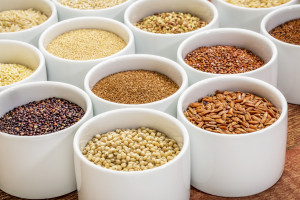Have you noticed an emergence of “new” grains on the market?
 Interestingly, these grains are not new and have actually been around for a really long time. They are; however, finally getting the attention they deserve. Many of these grains are high in fiber, packed with nutrients, and most are low glycemic – which means they don’t spike your blood sugar. And, some of the wheat varieties are even mild enough for those sensitive to modern wheat. Time to move over quinoa, there are some new (old) kids on the block.
Interestingly, these grains are not new and have actually been around for a really long time. They are; however, finally getting the attention they deserve. Many of these grains are high in fiber, packed with nutrients, and most are low glycemic – which means they don’t spike your blood sugar. And, some of the wheat varieties are even mild enough for those sensitive to modern wheat. Time to move over quinoa, there are some new (old) kids on the block.
Like quinoa, these grains are ideal for savory salads, yummy pilafs, stews and soups, or as a hearty hot cereal. Oh, the possibilities are endless.
Freekeh (pronounced freek-eh, also known as farik or frikeh) – is young green wheat that is harvested while the grains are still soft and filled with moisture. They are made with the ancient traditional process of fire roasting young grains and then removing the seared chaff to reveal the nutrient dense kernels. This grain is low glycemic and because the grain is harvested when it’s still young, it retains more protein, fiber, and minerals than mature wheat.
The story behind Freekeh is rather interesting, and I actually found a few slightly different variations. It was said that during a feud of two neighboring clans, one clan set fire to the other clan’s wheat fields. Although the entire crop burned, the farmers carefully gathered the charred grain from the ashes and cooked the roasted green wheat. Not only was the grain edible, a new tradition was born.
Farro – this hearty grain was a mainstay of the daily diet in ancient Rome. Known as the original ancestor of all wheat species, it’s actually made up of three grains – farro piccolo (einkorn), farro medio (emmer), and farro grande (spelt). Of the three, emmer wheat is sometimes called “true” Farro. Eventually, emmer was gradually abandoned in favor of durum wheat, which is easier to hull.
Today this “old world” heirloom grain is still highly regarded in Italy, where it has been grown for generations by Tuscan farmers and is featured in many traditional dishes. It is high in fiber and a good source of iron and protein. Farro is also easy to digest, allowing your body to readily absorb the nutrients.
Teff – the tiniest of all grains—about the size of a poppy seed —comes in a variety of colors, from white and red to dark brown and has been a staple of traditional Ethiopian cooking for thousands of years.
The grain has a very mild, nutty flavor, and it packs a serious nutritional punch. It is a good source of iron, calcium, magnesium, and zinc. It is high in protein, low glycemic and gluten free. It can be ground into flour. Delicious on its own or combined with other grains and vegetables. For some yummy recipes go HERE
Spelt – this variety of wheat was widely cultivated until the spread of fertilizers and mechanical harvesting left it by the wayside in favor of wheats more compatible with industrialization. Spelt can be used in place of common wheat in most recipes.
Spelt is higher and fiber and is a good source of iron and manganese. Because it can be more easily digested, it is considered to be mild wheat and many people with wheat intolerances have been able to tolerate it. But, remember Spelt is not gluten free. It has a chewy texture and sweet, nutlike flavor and is a great grain for hot cereal or to use in place of rice for pilaf, soup or cold salads. Flour milled from spelt makes excellent bread, pasta and baked goods.
Amaranth was a staple of Aztec culture, until Cortez, in an effort to destroy that civilization, decreed that anyone growing the crop would be put to death. Seeds were smuggled out to Asia, where local dialects referred to Amaranth as “king seed” and “seed sent by God” as a tribute to its taste and sustenance. Amaranth kernels are tiny and is a “pseudo-grain” – like quinoa and buckwheat, it’s not in the Poaceae botanical family, but is listed with other grains because its nutritional profile and uses are similar to “true” cereal grains.
Today amaranth is making its way back, thanks to a lively, peppery taste and a higher level of protein (it’s roughly 13-14% protein) compared to most other grains. In South America, it is often sold on the streets, popped like corn. Amaranth has no gluten, so it must be mixed with wheat to make leavened breads. It is popular in cereals, breads, muffins, crackers and pancakes.
Kamut – this ancient Khorasan wheat is produced under the KAMUT® brand. Here is how they describe themselves. KAMUT® khorasan wheat is an ancient wheat, guaranteed under the KAMUT® brand to be always grown certified organic, never hybridized or genetically modified and is prized for its nutrition, ease of digestibility, sweet nutty-buttery taste and firm texture. Compared to most modern wheat it has more protein, amino acids, vitamins and many minerals, especially selenium, zinc and magnesium.
The plump, golden kernels of whole grain Kamut® Khorasan wheat are a nutritious source of selenium, zinc, magnesium and iron. Kamut® wheat is exceptionally high in protein, containing 7 grams of protein per serving, and a good source of dietary fiber. A nutritional powerhouse, Kamut® grain is perfect for anyone looking for a high protein, low fat addition to their menu. Check out the recipes from Kamut HERE
These grains are easy to find in any healthy food store. Bob’s Red Mill brand is one of my favorites and can be found in most grocery stores.
So, now that you finally figured out how to pronounce quinoa (Kween-wa), you have a few new words to add to your vocab list.
Do you use these grains? What are your favorite recipes? I know I will be experimenting and will share my favorite results with you.
Need some more inspiration? Oldway’s Whole Grain Council’s website is a great resource for recipes that you can search for by grain. Check it out HERE
